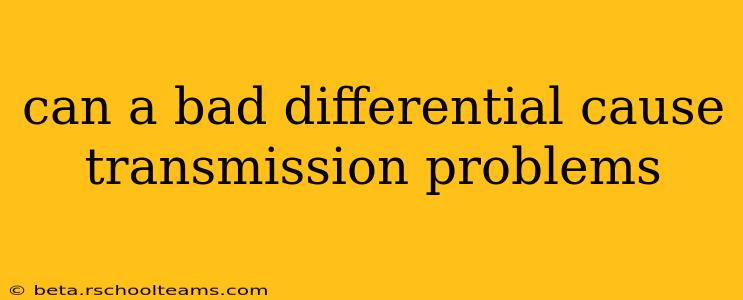Can a Bad Differential Cause Transmission Problems?
A failing differential can definitely cause problems that seem like transmission issues, leading to confusion and potentially costly repairs if not diagnosed correctly. While the transmission and differential are separate components, they work together within the drivetrain, and problems in one can easily mimic symptoms of failure in the other. Let's explore this complex relationship.
What is a Differential and How Does it Work?
Before diving into the potential transmission problems, understanding the differential's function is crucial. The differential is a gearbox located within the rear axle (or front axle in some vehicles) that allows the wheels to rotate at different speeds. This is essential when cornering, as the outside wheel needs to travel a greater distance than the inside wheel. A faulty differential can disrupt this smooth power distribution, leading to symptoms that are easily mistaken for transmission issues.
How Can a Bad Differential Mimic Transmission Problems?
Several problems with the differential can manifest as transmission troubles. Here are some key indicators:
-
Whining or Grinding Noises: A failing differential often produces whining or grinding noises, particularly during acceleration or cornering. This is often mistaken for transmission gear whine or bearing issues. The noise can vary in intensity and pitch depending on the nature of the differential problem.
-
Vibration: Excessive vibration, especially felt during acceleration or when turning, can point to problems in the differential. A faulty differential can cause uneven power distribution, leading to vibrations that are frequently attributed to transmission problems.
-
Difficulty Shifting Gears (Automatic Transmission): While unusual, a severely damaged differential, particularly one with internal component failure, can sometimes cause the transmission to struggle. This is typically due to the added strain on the drivetrain and can even trigger fault codes in some vehicles.
-
Limited Slip Differential Problems: Vehicles equipped with limited-slip differentials (LSDs) to improve traction can experience their own set of problems, including chattering or a binding sensation when cornering. These symptoms can easily be misinterpreted as transmission-related problems.
-
Uneven Wheel Rotation: In extreme cases, a broken differential can lead to one or both wheels spinning erratically, even if the transmission is functioning correctly. This indicates a severe mechanical problem within the differential.
What Are the Actual Transmission Problems?
It’s vital to distinguish between true transmission problems and those that are actually differential issues. Actual transmission problems might involve:
- Transmission Slipping: The transmission doesn't engage properly, causing the engine to rev without corresponding acceleration.
- Hard Shifting: Difficulty changing gears, often accompanied by jolting or jerking.
- Leaking Transmission Fluid: Visible fluid leaks around the transmission housing.
- Internal Transmission Damage: This is generally indicated by a range of erratic behaviors and is often accompanied by metallic noises or complete failure to move.
How Can I Tell If It's the Differential or Transmission?
Diagnosing the problem requires a professional inspection. A mechanic will usually conduct the following:
- Visual Inspection: Checking for leaks, damage, or unusual wear and tear on both the transmission and differential.
- Road Test: Observing the vehicle's behavior under various driving conditions to pinpoint the source of the problem.
- Diagnostic Scan: Utilizing a diagnostic scanner to check for any stored fault codes that may indicate transmission or drivetrain issues.
- Component Testing: Specialized tests may be needed to fully evaluate the health of each component.
In Conclusion:
While a bad differential can certainly cause symptoms that mimic transmission problems, it's crucial to remember that they are separate systems. If you experience issues like whining noises, vibrations, or unusual wheel behavior, don't automatically assume it's your transmission. Seek professional diagnosis to determine the root cause and prevent costly mistakes. Ignoring a differential problem can lead to further damage and potentially more extensive repairs.
